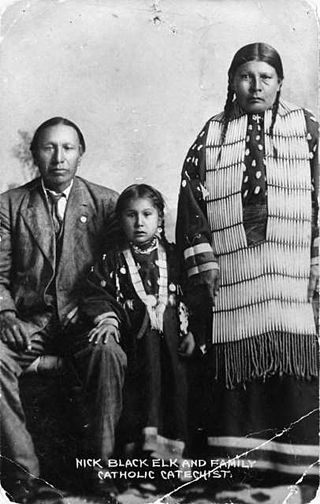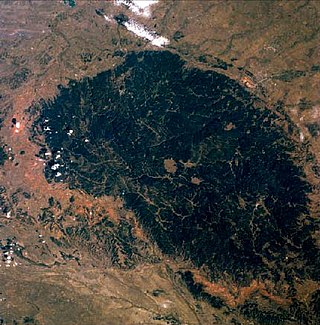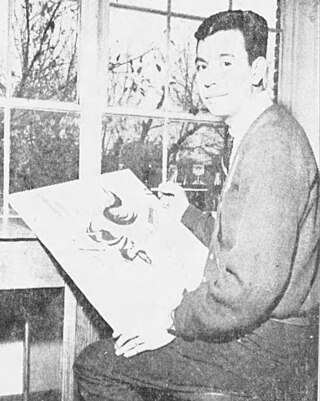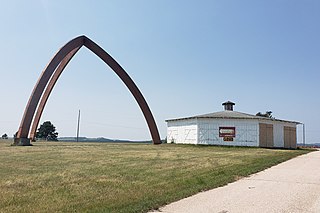Related Research Articles

The Lakota are a Native American people. Also known as the Teton Sioux, they are one of the three prominent subcultures of the Sioux people, with the Eastern Dakota (Santee) and Western Dakota (Wičhíyena). Their current lands are in North and South Dakota. They speak Lakȟótiyapi—the Lakota language, the westernmost of three closely related languages that belong to the Siouan language family.

The Sioux or Oceti Sakowin are groups of Native American tribes and First Nations people from the Great Plains of North America. The Sioux have two major linguistic divisions: the Dakota and Lakota peoples. Collectively, they are the Očhéthi Šakówiŋ, or "Seven Council Fires". The term "Sioux", an exonym from a French transcription ("Nadouessioux") of the Ojibwe term "Nadowessi", can refer to any ethnic group within the Great Sioux Nation or to any of the nation's many language dialects.

Sitting Bull was a Hunkpapa Lakota leader who led his people during years of resistance against United States government policies. Sitting Bull was killed by Indian agency police on the Standing Rock Indian Reservation during an attempt to arrest him at a time when authorities feared that he would join the Ghost Dance movement.

The Mount Rushmore National Memorial is a national memorial centered on a colossal sculpture carved into the granite face of Mount Rushmore in the Black Hills near Keystone, South Dakota, United States. Sculptor Gutzon Borglum designed the sculpture, called Shrine of Democracy, and oversaw the project's execution from 1927 to 1941 with the help of his son, Lincoln Borglum. The sculpture features the 60-foot-tall (18 m) heads of four United States presidents: George Washington, Thomas Jefferson, Theodore Roosevelt, and Abraham Lincoln, chosen to represent the nation's birth, growth, development and preservation, respectively. Mount Rushmore attracts more than two million visitors annually to the memorial park which covers 1,278 acres. The mountain's elevation is 5,725 feet (1,745 m) above sea level.

The Wounded Knee Massacre, also known as the Battle of Wounded Knee, was the deadliest mass shooting in American history, involving nearly three hundred Lakota people shot and killed by soldiers of the United States Army. The massacre, part of what the U.S. military called the Pine Ridge Campaign, occurred on December 29, 1890, near Wounded Knee Creek on the Lakota Pine Ridge Indian Reservation in South Dakota, following a botched attempt to disarm the Lakota camp. The previous day, a detachment of the U.S. 7th Cavalry Regiment commanded by Major Samuel M. Whitside approached Spotted Elk's band of Miniconjou Lakota and 38 Hunkpapa Lakota near Porcupine Butte and escorted them five miles westward to Wounded Knee Creek, where they made camp. The remainder of the 7th Cavalry Regiment, led by Colonel James W. Forsyth, arrived and surrounded the encampment. The regiment was supported by a battery of four Hotchkiss mountain guns. The Army was catering to the anxiety of settlers who called the conflict the Messiah War and were worried the Ghost Dance signified a potentially dangerous Sioux resurgence. Historian Jeffrey Ostler wrote in 2004, "Wounded Knee was not made up of a series of discrete unconnected events. Instead, from the disarming to the burial of the dead, it consisted of a series of acts held together by an underlying logic of racist domination."

Heȟáka Sápa, commonly known as Black Elk, was a wičháša wakȟáŋ and heyoka of the Oglala Lakota people. He was a second cousin of the war leader Crazy Horse and fought with him in the Battle of Little Bighorn. He survived the Wounded Knee Massacre in 1890. He toured and performed in Europe as part of Buffalo Bill's Wild West.
White Buffalo Calf Woman or White Buffalo Maiden is a sacred woman of supernatural origin, central to the Lakota religion as the primary cultural prophet. Oral traditions relate that she brought the "Seven Sacred Rites" to the Lakota people.

Red Cloud was a leader of the Oglala Lakota from 1865 to 1909. He was one of the most capable Native American opponents whom the United States Army faced in the western territories. He led the Lakota to defeat the United States during Red Cloud's War, establishing the Lakota as the only nation besides the British to defeat the United States on American soil. The largest action of the war was the 1866 Fetterman Fight, with 81 US soldiers killed; it was the worst military defeat suffered by the US Army on the Great Plains until the Battle of the Little Bighorn 10 years later.

Black Elk Peak, formerly known as Harney Peak, is the highest natural point in the U.S. state of South Dakota and the Midwestern United States. It lies in the Black Elk Wilderness area, in southern Pennington County, in the Black Hills National Forest. The peak lies 3.7 mi (6.0 km) west-southwest of Mount Rushmore. At 7,244 feet (2,208 m), it is the highest summit in the United States east of the Rocky Mountains. Though part of the North American Cordillera, it is generally considered to be geologically separate from the Rocky Mountains.

Crazy Horse was a Lakota war leader of the Oglala band in the 19th century. He took up arms against the United States federal government to fight against encroachment by White American settlers on Native American territory and to preserve the traditional way of life of the Lakota people. His participation in several famous battles of the Black Hills War on the northern Great Plains, among them the Fetterman Fight in 1866, in which he acted as a decoy, and the Battle of the Little Bighorn in 1876, in which he led a war party to victory, earned him great respect from both his enemies and his own people.

Iron Tail was an Oglala Lakota Chief and a star performer with Buffalo Bill's Wild West. Iron Tail was one of the most famous Native American celebrities of the late 19th and early 20th centuries and a popular subject for professional photographers who circulated his image across the continents. Iron Tail is notable in American history for his distinctive profile on the Buffalo nickel or Indian Head nickel of 1913 to 1938.

The Oglala are one of the seven subtribes of the Lakota people who, along with the Dakota, make up the Očhéthi Šakówiŋ. A majority of the Oglala live on the Pine Ridge Indian Reservation in South Dakota, the eighth-largest Native American reservation in the United States.

The Black Hills is an isolated mountain range rising from the Great Plains of North America in western South Dakota and extending into Wyoming, United States. Black Elk Peak, which rises to 7,244 feet (2,208 m), is the range's highest summit. The Black Hills encompass the Black Hills National Forest. The name of the hills in Lakota is Pahá Sápa. The Black Hills are considered a holy site. The hills are so called because of their dark appearance from a distance, as they are covered in evergreen trees.

The United States government illegally seized the Black Hills – a mountain range in the US states of South Dakota and Wyoming – from the Sioux Nation in 1876. The land was pledged to the Sioux Nation in the Treaty of Fort Laramie, but a few years later the United States illegally seized the land and nullified the treaty with the Indian Appropriations Bill of 1876, without the tribe's consent. That bill "denied the Sioux all further appropriation and treaty-guaranteed annuities" until they gave up the Black Hills. A Supreme Court case was ruled in favor of the Sioux in 1980. As of 2011, the court's award was worth over $1 billion, but the Sioux have outstanding issues with the ruling and have not collected the funds.

Arthur Douglas Amiotte is an Oglala Lakota Native American painter, collage artist, educator, and author.

Red Shirt was an Oglala Lakota chief, warrior and statesman. Red Shirt supported Crazy Horse during the Great Sioux War of 1876-1877 and the Ghost Dance Movement of 1890, and was a Lakota delegate to Washington in 1880. Red Shirt surrendered with Crazy Horse in 1877. After the surrender he moved to an area that is now known as Red Shirt, SD. Red Shirt was one of the first Wild Westers with Buffalo Bill's Wild West and a supporter of the Carlisle Native Industrial School. Red Shirt became an international celebrity Wild Westing with Buffalo Bill's Wild West and his 1887 appearance in England captured the attention of Europeans and presented a progressive image of Native Americans.
Bismuth is a ghost town in the Black Hills of Custer County, South Dakota, United States.
SuAnne Big Crow was a basketball player for the 1989 South Dakota champion Pine Ridge High School team. A member of the Oglala Sioux, she was born and raised on the Pine Ridge Indian Reservation in southwestern South Dakota, and died as a teenager in a car accident. SuAnne was featured in Ian Frazier's book On the Rez, and in 2022, a feature-length documentary about her life, titled Big Crow, was released in the United States.

Chase Iron Eyes is a Native American activist, attorney, politician, and a member of the Oglala Sioux Tribe. He is a member of the Lakota People's Law Project and a co-founder of the Native American news website Last Real Indians. In April 2016 he announced his candidacy for the United States House of Representatives for North Dakota's at-large congressional district. He lost to incumbent Kevin Cramer.

The Sitting Bull Crystal Cavern Dance Pavilion is a historic event venue on the south side of U.S. Highway 16 northeast of Rockerville, South Dakota, near the Sitting Bull Crystal Caverns. Built in 1934, it hosted the Duhamel Sioux Indian Pageant, a Lakota tourist performance created by Black Elk in 1927. The pageant ran every summer until its discontinuation in 1957. A major attraction in the 1930s, its purpose was to not only profit off of tourism to the nearby Black Hills and Mount Rushmore but also—according to Black Elk—to represent Lakota traditions in a respectful, authentic way. It was added to the National Register of Historic Places in 1995 as a venue of enduring cultural and religious significance, and for its association with Black Elk.
References
- ↑ Frommer, Frederic J. (2001-08-19). "Black Hills Are Beyond Price to Sioux". Los Angeles Times. Associated Press. Retrieved 2022-03-28.
- ↑ On the Rez by Ian Frazier, page 117
- ↑ "Charlotte Black Elk". IMDb . Retrieved 13 September 2016.
- ↑ "PBS - THE WEST - Like Grass Before the Sickle". PBS . Retrieved 13 September 2016.
- ↑ Time Present, Time Past by Bill Bradley